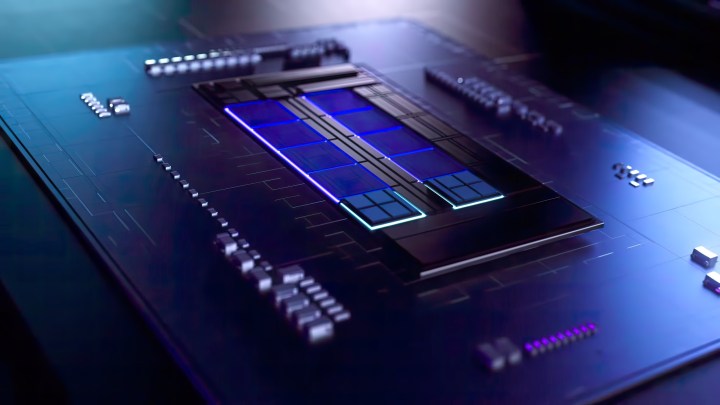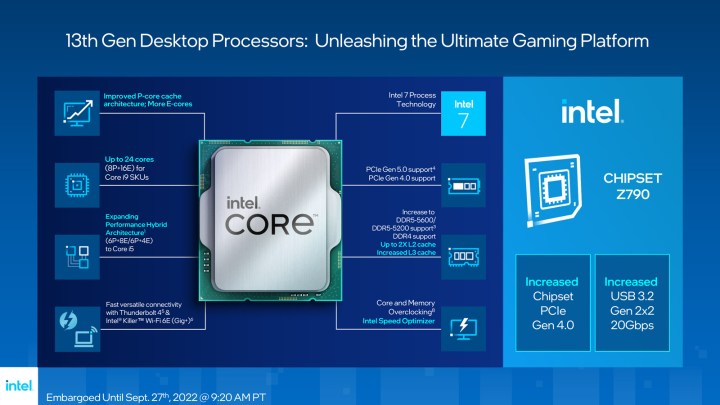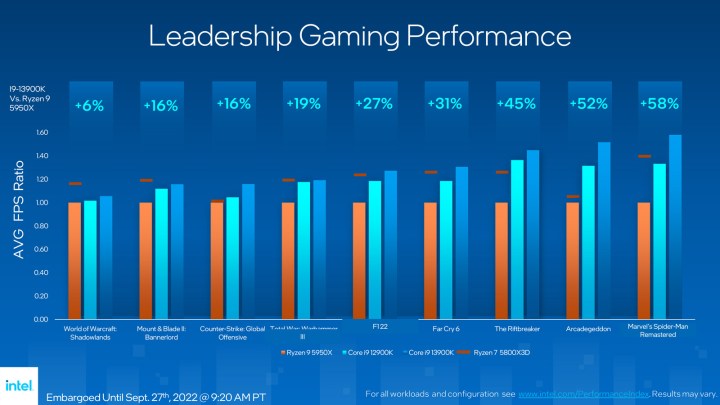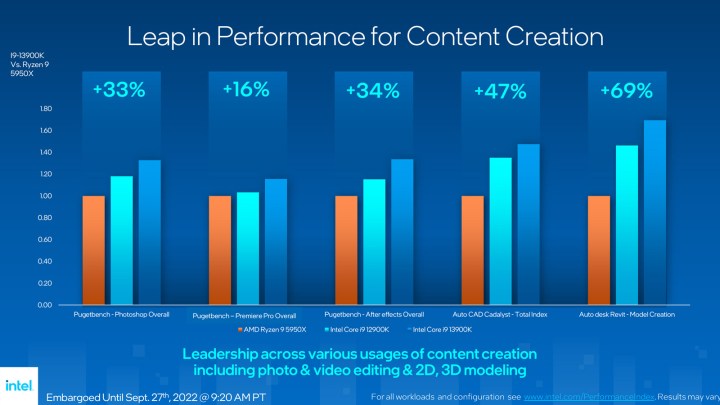Raptor Lake is Intel’s 13th generation of processors, and it’s one of the most exciting hardware launches of the year. Following up on the momentum it built with its Alder Lake line of CPUs, Intel is looking to retain some of the hard-fought performance crowns. It’s got new and stiffer competition, though, in the form of AMD’s Ryzen 7000 series of Zen 4 CPUs, which have already impressed for their efficiency and performance.
How will these new CPU lines fair when going head to head? Here’s everything you need to know about Raptor Lake.
Pricing and availability

The first Raptor Lake processors will arrive on October 20, 2022. Intel says its 13th-gen lineup will include 22 processors total, but only six are arriving on October 20. As usual, Intel is releasing unlocked versions of its i5, i7, and i9 CPUs, along with unlocked variants that don’t have integrated graphics. Here’s how list pricing looks:
- Core i9-13900K — $590
- Core i9-13900KF — $564
- Core i7-13700K — $410
- Core i7-13700KF — $385
- Core i5-13600K — $320
- Core i5-13600KF — $295
Close to launch, prices will likely be slightly higher than the numbers listed by Intel. Last-gen’s Core i9-12900K, for example, sold for around $620 to $650 near launch (though it settled back down a few weeks later). Availability shouldn’t be an issue, but similar to pricing, inventory might be tight near release day.
Specs

Raptor Lake is largely an upgrade to Alder Lake, utilizing the same node and hybrid architecture. We’ll dig more into that architecture in the next section, but for specs, Intel is focusing mainly on higher core counts and clock speeds, as well as boosted cache to compete with gaming processors like the Ryzen 7 5800X3D.
| Core i9-13900K | Core i7-13700K | Core i5-13600K | |
| Cores/threads | 24 (8+16)/32 | 16(8+8)/24 | 14(6+8)/20 |
| Base clock speed | 3GHz (P-core), 2.2GHz (E-core) | 3.4GHz (P-core), 2.5GHz (E-core) | 3.5GHz (P-core), 2.6GHZ (E-core) |
| Boost clock speed | Up to 5.8GHz | Up to 5.4GHz | Up to 5.1GHz |
| L2 cache | 32MB | 24MB | 20MB |
| L3 cache | 36MB | 30MB | 24MB |
| Max boost power | 253W | 253W | 181W |
| Price | $589 | $409 | $319 |
Although core counts are up, Intel isn’t adding more P-cores, rather opting to boost the E-core count instead. That could help with heavy multi-tasking, but the E-cores don’t support Hyperthreading. You get 24 cores on the Core i9-13900K, for example, but only 32 total threads.
Clock speeds are up as well, with the flagship Core i9-13900K clocking in at 5.8GHz on a single core. Intel has shared demos of a single Raptor Lake core reaching over 8GHz with LN2 extreme overclocking, suggesting that you may be able to push your own clock speeds higher, given you have enough power and cooling.
The biggest departure from Alder Lake comes in the form of cache. Raptor Lake comes with double the amount of L2 cache, which could help in cache-sensitive games like Far Cry 6. We’ll have to see if those improvements show up in third-party testing, though.
Power limits remain high, as they were on 12th-gen CPUs. Intel is pushing the envelope a bit harder this time around, with a 12W boost on the i9 and i7 and a 31W jump on the i5. Intel’s 12th-gen processors already ran hot, so the extra power and core count probably won’t help the situation much. We’ll have to wait until the processors are in-hand to see if that limits performance, though.
Architecture

Raptor Lake is very similar to Alder Lake, and that becomes clear when you look closer at the architecture. 13th-gen CPUs use the same Intel 7 manufacturing process, and they adopt a hybrid architecture. Cores are split up into performance (P) cores and efficient (E) cores to boost multitasking performance without high power and thermal demands.
It’s not clear what core designs Intel will use, but rumors say Intel is keeping with the same Gracemont E-cores that showed up in Alder Lake, just boosting the number of them on the chip. Intel has confirmed that the P-cores use the new Raptor Cove microarchitecture, however. The updated design offers “improved speed paths,” according to Intel.
In practical terms, Intel says it was able to optimize the core voltage as frequency increased, allowing Raptor Lake processors to hit higher clock speeds than their Alder Lake counterparts. The new design also offers 2MB of L2 cache per core, double what was available on Alder Lake.
To accommodate more power, Intel is using a larger die that fits more E-cores along with their cache. The various cores, and their differing architectures, are brought together by a larger compute fabric that stretches across the die. The new fabric supports clock speeds up to 900MHz than the previous iteration, as well as opens up a pool of up to 36MB of shared L2 cache.
Although there are a few significant changes under the hood, Intel says the majority of its performance improvements still come down to frequency and thread count. In addition to hardware improvements, Intel says it’s continuing to optimize features like Intel Thread Director, which helps allocate workloads to the most appropriate core.
Expected performance

Intel has much to build on, with its existing Alder Lake CPUs being performance leaders in most categories for much of their life, including monster chips like the Intel Core i9-12900KS. However, Raptor Lake will go much further, and with clock speeds and core counts rising across the board, there’s potential for impressive performance and serious competition with AMD’s latest designs.
As with all first-party test results, no matter how deliberately self-deprecating or realistic-looking, we need to view them with a skeptic’s eye, but what Intel is promising with Raptor Lake is quite exciting.

The additional 600MHz on the Raptor Cove P cores leads to a big jump in frame rates in different games. While the improvement isn’t always dramatic — in some cases as limited as 6% — some saw enormous leaps over the 12900K, with over 50% improvement in frame rates. The 13900K also dominates the AMD Ryzen 5950X in many of these tests, but there is a real elephant in the room that will give Intel fans pause: The 5800X3D remains extremely competitive with the 13900K in more than half the games shown here. Considering the Ryzen 7000-series CPUs offer improved performance against that chip across the board, the 13900K is going to have a stiff fight on its hands if it wants to steal the gaming crown.

The tables might be different when it comes to productivity, as the sheer number of cores in the top CPUs — 24 in the 13900K — should give Intel an advantage against all AMD processors in some content-creation workloads. In some tasks, Intel claims the 13900K is up to 70% faster than the 12900K, which was, until AMD’s recent chip debuts, a class leader in productivity. The 13900K also has specialized acceleration in Photoshop and Blender, delivering around 30% improvements in specific content-creation workloads.
We’ll have to see how well this is reflected throughout the line of CPUs, as Intel has only provided in-depth numbers for its flagship 13900K so far. In the weeks to come, we’ll no doubt hear more, and when these chips are in the hands of reviewers, a head-to-head with Ryzen 7000 is going to be very interesting indeed.
Also of note is Intel’s power management scaling with Rocket Lake. It claims to be able to achieve 12900K-like multithreaded performance with its 13900K when limiting it to just 65W. That’s around 25% of the power of the 12900K for similar capabilities. For small-form-factor systems looking to maximize performance, this could be an intriguing option for Rocket Lake buyers. Considering AMD’s Ryzen 7000 is touting its Eco Mode power limiting for smaller systems, too, it’s clear the industry is moving in the direction of offering high-power, high-performance parts, with the option of cutting them back from their peak to make big power and thermal savings.

Motherboard and chipset
Gamers looking to move to 12th-gen Alder Lake this year will get some good news if they’re eyeing a Raptor Lake upgrade. Intel is using the same LGA1700 socket as the previous generation, so most Z690 motherboards will support 13th-gen CPUs. Intel is debuting Z790 motherboards along with the release date, as well.
Regardless of the chipset, you’ll be able to use DDR4 or DDR5 memory as long as you have a motherboard that supports the memory standard you want to use. Although many Z690 motherboards have already brought support for 13th-gen CPUs, most B-series and H-series boards haven’t. You’ll want to consult your motherboard vendor to make sure the new generation is supported.
Editors’ Recommendations




